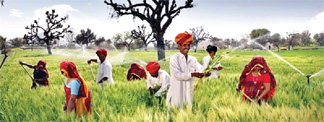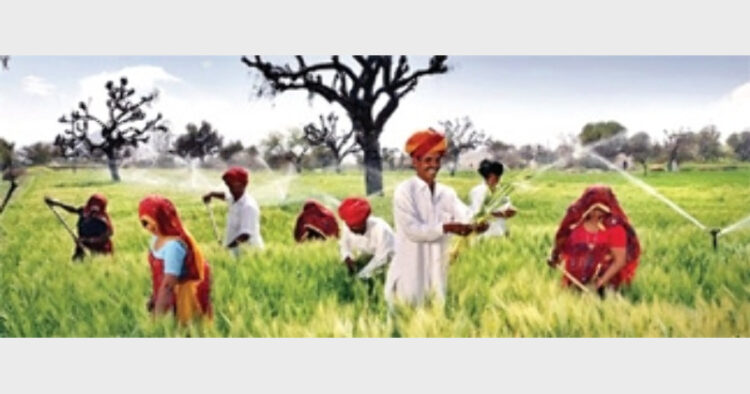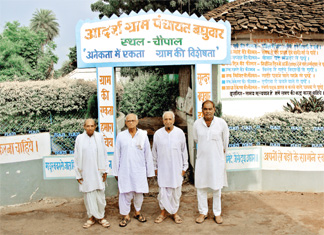Modi government gives a big push to Agriculture sector?
 The Modi Government promises to explore new grounds and take new policy initiatives in several areas of national endeavour. Among these, one of the most significant is the new emphasis on agriculture. In his campaign speeches, Shri Narendra Modi repeatedly referred to the condition of agriculture and the cultivators and his commitment to ensure agriculture and farmers receive their due. After forming the government, he made it a point to be personally present on the Founders Day of the Indian Council of Agricultural Research, where he exhorted the scientists to ensure that not only the productivity of Indian agriculture rises but also the cultivator becomes affluent, and has more money in his pocket. It is indeed significant that after the defence establishment, the first major national establishment he chose to visit was the agricultural establishment. This perhaps gives an idea of the priorities of his government.
The Modi Government promises to explore new grounds and take new policy initiatives in several areas of national endeavour. Among these, one of the most significant is the new emphasis on agriculture. In his campaign speeches, Shri Narendra Modi repeatedly referred to the condition of agriculture and the cultivators and his commitment to ensure agriculture and farmers receive their due. After forming the government, he made it a point to be personally present on the Founders Day of the Indian Council of Agricultural Research, where he exhorted the scientists to ensure that not only the productivity of Indian agriculture rises but also the cultivator becomes affluent, and has more money in his pocket. It is indeed significant that after the defence establishment, the first major national establishment he chose to visit was the agricultural establishment. This perhaps gives an idea of the priorities of his government.
Modi has continued to give expression to his concern for agriculture in all his public speeches. In his Independence Day speech, he pointedly recalled Shri Lal Bahadur Shastri’s slogan of Jai Jawan, Jai Kisan (Hail the Soldier, Hail the Cultivator). In his speech in Haryana this week, while giving expression to his deep and urgent concern for the cultivators, he referred to the Pradhan Mantri Gram Sinchai Yojana (the Prime Minister’s Village Irrigation Scheme), which was earlier mentioned in the President’s address and for which some provision has already been made in the budget. The Pradhan Mantri Gram Sadak Yojana, which was introduced by Shri Atal Behari Vajpayee has, brought a lot of good in the rural areas of India, but the Village Irrigation Scheme promises to be even more beneficial. Many of the larger irrigation projects across India remain grossly underutilised because of the failure to build smaller distributaries and channels that actually take the water to the field. Also, in the near vicinity of almost every village of India, there is some source of water which, with some care and investment, can be utilised for providing significant amount of irrigation. If the new Gram Sinchai Yojana succeeds in tapping all these resources, it can change the rural landscape.
But what is important in the agricultural policy of the new government is not the announcement of one scheme or the other, however significant it may be; what is much more important is the new and repeated emphasis on agriculture that is being reflected at the highest level of the government. According such high priority to agriculture is entirely contrary to the policy pursued by the governments and planners of India since Independence. In the political-economy of Jawaharlal Nehru, national development was almost synonymous with the development of a sufficiently large middle class capable of consuming industrial products. Therefore, the service sector got the highest priority in the planning process. This sector included both transport and communication services that were deemed necessary for developing an industrial economy, and various kinds of social and administrative services. It aimed at provide middle-class employment to a large number of people.
Industrial development, which was said to be the core concern of Nehruvian thinking and about which Nehru spoke so often and so eloquently, nevertheless received a lower priority than the services. Agriculture, in this scheme of things, had the last priority. Agriculture was not important in itself; its only role was to be the provider of cheap food for the growing urban middle class and raw materials for the industry.
This line of economic thinking was discussed quite openly and extensively during the early phases of planning in India. Pandit Deendayal Upadhyaya, the ideological mentor of the party that Shri Narendra Modi now represents, extensively discusses it in his seminal books, Bharatiya Artha Niti: Vikaski Ek Disha and The Two Plans: Promise, Performance and Prospects. Written towards the end of the fifties, the first of these provides a comprehensive analysis of the economic issues of the time and the latter undertakes a comprehensive analysis of the First Plan, which had been completed by then, and the Second Plan, which had been already proposed. These books also provide a framework of a more agriculture friendly political economy rooted in and in conformity with classical Indian thought and ways.
In these books, Pandit Deendayal seems repelled by the prevalent Nehruvian thinking of treating agriculture only as the provider of surplus for the other two sectors. He, on the other hand, believed that no development is possible without raising income of cultivators in agriculture sector. When the incomes of cultivators rise, they shall consume more of industrial products and services and thus provide the impetus for the growth of output and employment in these sectors.
Thinking thus and drawing inspiration from the Indian economic thought as expressed in the extensive civilisational literature of India. He laid down a clear order of priorities in economics: First, Agriculture; second, Manufacture; third, Trade and, fourth, social services.
But Nehruvian polity established an inverted order of priorities in India, in which services occupied the first place and agriculture the last. India has followed this path for the last six decades or more. Today, nearly 50 percent of our national GDP comes from Services (including utilities and construction), 16 percent from Trade, 15 percent from Manufacture and only 12 percent from Agriculture. This is probably the first time in the history of Independent India that someone has authoritatively spoken about correcting this great and persistent distortion in the political-economy of India.
Govt’s Re 1 becomes Rs 2
|
|
Also Read These Special Focus Related |
Perhaps, it needed someone trained in the thought of Pandit Deendayal to carry out this correction. It must be mentioned that before articulating this new prioritisation of agriculture, and also manufacture, the BJP governments in the states have in practice tried to move the economies of their states in this direction. In the 7 years between 2004-05 and 2011-12, SDP from manufacture in Gujarat has more than doubled, while that from agriculture has increased by 70 percent. Production of Wheat in the state has increased from 6.5 lakh tons in 2001-02 to 50 lakh tons in 2010-11. Production of Cotton, the other main crop of the state, has increased from 21 lakh to 97 lakh bales during the same period. Madhya Pradesh is in fact the only state of India where the share of agriculture in the total SDP has somewhat increased during the last decade.
Pandit Deendayal Upadhyay’s thinking on economy has thus been implemented in practice by the BJP state governments and the same thought is now being implemented by Shri Modi at all-India level.
-Dr JK Bajaj? (The writer is the Director, Centre for Policy Studies, New Delhi)?




 Rajiv Gandhi was widely quoted saying that the government’s one rupee remains only 15 paisa when it reaches the villages. But the Sangh swayamsevaks at Baghuwar Village under Narsinghpur district of Madhya Pradesh have set a precedent worth emulating. This village displays a unique example of government-people participation where corruption level is zero. Just 9 km from Kareli tehsil, the village shows the way how to utilise government funds for development. It becomes significant after the announcement of Prime Minister Shri Narendra Modi on August 15 that one MP has to develop one village every year.
Rajiv Gandhi was widely quoted saying that the government’s one rupee remains only 15 paisa when it reaches the villages. But the Sangh swayamsevaks at Baghuwar Village under Narsinghpur district of Madhya Pradesh have set a precedent worth emulating. This village displays a unique example of government-people participation where corruption level is zero. Just 9 km from Kareli tehsil, the village shows the way how to utilise government funds for development. It becomes significant after the announcement of Prime Minister Shri Narendra Modi on August 15 that one MP has to develop one village every year.









Comments